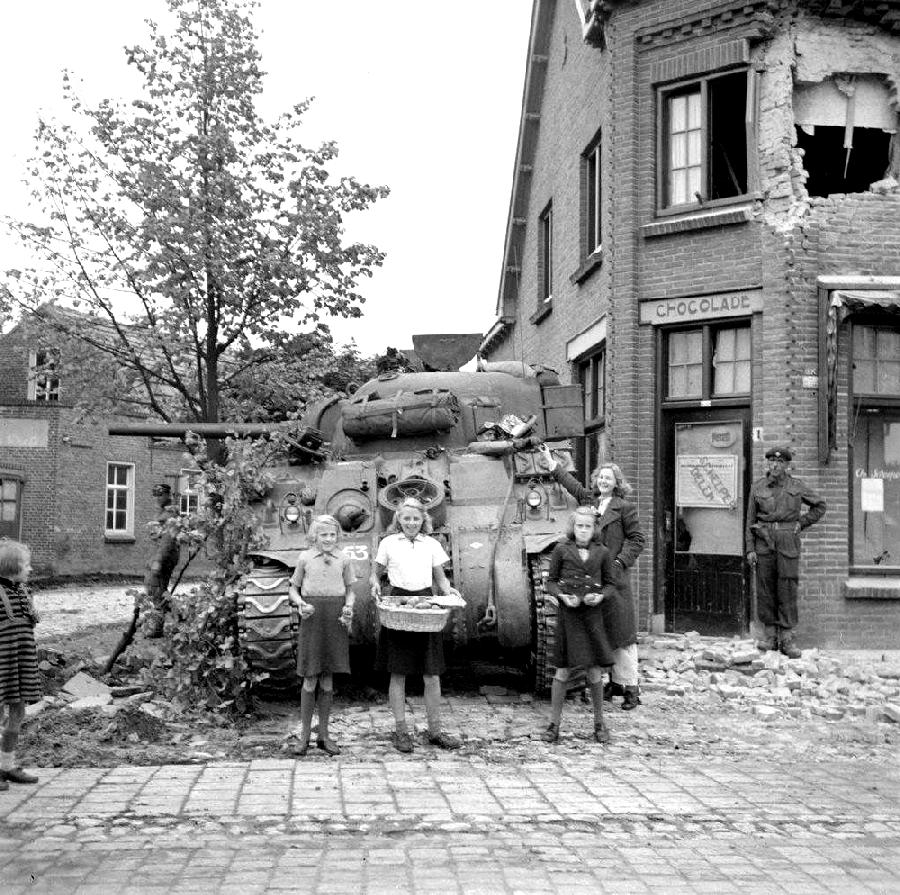
World War II: Allied Sweep into Belgium -- Aalst (September 18, 1944)

Figure 1.--Here we see Belgian girls with the British Guards Sherman tank in Aalst, a town in northwestern Belgium (September 18, 1944). As the Allies swept north from France, much of the German Army withdrew from Antwerp and western Belgium. A well dug-in German force made a stand in Aalst. The girls have brought some fruit to the British soldiers liberating their town.
|
|
Aalst is a town in north-central Belgium, a Flemish area of Belgium. Aalst and other Belgium towns and cities began to industrislize (mid-19th century). This led to a political movement led by Father Adolf Daens and his Christene Volkspartij. They emerged as a strong local defender of workers' rights. This was in response to to the Papal bull, Rerum novarum, which recognized worker rights. Daens felt that the Pope did not go enough and esentially created a Catholic splinter movement". [Cook, p. 89.] Fascist thought gained some support during the inter-war era. The Vlaamsch Nationaal Verbond (Flemish National Front) achieved some support. Aalst, along with Brussels and Antwerp were the strongest supporters for Fascist thought, although a minority. [Clough, p. 124.] The Germans tended to favor the Flemish during both World Wars. The Allies swept north into Belgium from France (September 1944). The Germans for the most part after Falaise did not make a stabnd in France or western Belgium. They even evacuated the all imoortant port of Antwerp. They did stand in the Steldt Estuary. A small German garison stood and fought at Aalst. The Allies plastrered the Germabns with an air attack and artillery shelling. On the second day of Operation Market Garden (September 18), a column of the British Guards Armoured rolled into the southern outskirts of Aalst. Commanded by Col. Joe Vandeleur, the British tanks encountered what was left of the German troops. They Germans were dug in but heavily-damaged by the Allied air raid and artillery shelling (September 17). The Germans tried to hold Aalst to disrupt the Allied move in northeast from Antwerp toward the Netherlands. For the Allies, Aalst was an important crossroads needed to keep the columns of armour moving was to relieve the Allied airborn troops which were seizing bridges in the Netherlands as part of Market Garden.
Sources
Clough, Shepard B. "IX: The Flemish Movement" in In Goris, Jan-Albert Goris. Belgium. The United Nations (Berkeley, CA: University of California Press, 1946).
Cook, Bernard A. (2004). Belgium: A History. Studies in Modern European History. 50 (New York, NY: Peter Lang Publishing, Inc, 2004).
CIH -- WW II

Navigate the CIH World War II Section:
[Return to Main World War II Allied sweep through Brlgium page]
[Return to Main World War II liberation of Belgium page]
[Return to Main World War II campaign page--second phase]
[Return to Main World War II offemse slows page]
[Biographies]
[Campaigns]
[Children]
[Countries]
[Deciding factors]
[Diplomacy]
[Geo-political crisis]
[Economics]
[Home front]
[Intelligence]
[POWs]
[Resistance]
[Race]
[Refugees]
[Technology]
[Bibliographies]
[Contributions]
[FAQs]
[Images]
[Links]
[Registration]
[Tools]
[Return to Main World War II page]
[Return to Main war essay page]
Created: 12:44 PM 4/30/2018
Last updated: 12:45 PM 4/30/2018



